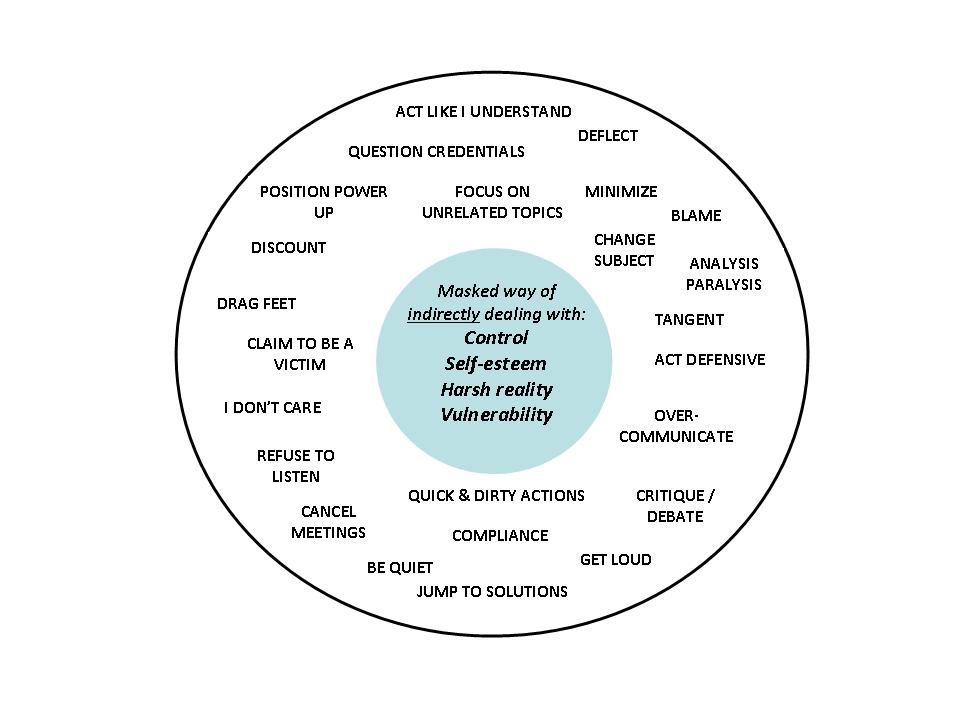Tips for Managing Resistance
Jan 11, 2017
It was time for my young daughters to learn how to ride a bike. My older daughter, Hannah, was clearly uncomfortable and afraid. She challenged me STRAIGHT ON. When I asked for her to get on the bike, she clearly and directly said no. She pitched a fit, engaged in a full one temper tantrum and ran back into the house. My younger daughter Ainsley, while equally afraid, chose a different tactic. She faked sick. She asked me to explain over and over again what she was to do before she would even get on the bike. Both children dealt with fears of loss of control and vulnerability. One was resistant, the other was not. And the resistant one wasn’t Hannah. It was Ainsley.
As consultants, we encounter resistance all the time. We propose a change, give difficult feedback and suggest alternatives to transform business processes to clients who will do one of three things:
- Option 1 - Accept our recommendations and partner with us to transform suggestions into reality.
- Option 2 - Discuss the content of our recommendations, suggest alternatives, agree with parts, disagree with other parts and make decisions on what aspects of our suggestions they want to go forth with and which aspects they want to table.
- Option 3 - Avoid discussion of content using a variety of different techniques that make us as the consultant feel spun up and stuck – unsure of how to get a meeting that is going horribly off track back on track.
Option three is the essence of resistance. Resistance is not disagreement of content (our analysis, our suggestions, etc.) Resistance is a masked or cloaked way of indirectly dealing with 1) issues of control 2) issues of self-esteem 3) dealing with harsh reality and/or 4) issues of vulnerability. If the client is open about their concerns about control, self-esteem, harsh reality and vulnerability, it is not resistance - just reasonable objections.
Let me share with you a few tips for how to navigate the tricky terrain of resistance.
THE FACES OF RESISTANCE
Resistance is happening when a client uses behaviors that distracts from the content level of the meeting.
 I was the consultant to David, the CEO of a medium sized nonprofit organization. Employees of a team led by Bill came to David to express extreme frustration with Bill’s behavior. I was brought in to do a 360 degree assessment on Bill and I had discovered that Bill’s leadership style could best be described as a “scorched earth” because of the amount of emotional damage Bill had caused his team.
I was the consultant to David, the CEO of a medium sized nonprofit organization. Employees of a team led by Bill came to David to express extreme frustration with Bill’s behavior. I was brought in to do a 360 degree assessment on Bill and I had discovered that Bill’s leadership style could best be described as a “scorched earth” because of the amount of emotional damage Bill had caused his team.
David and I sat down with Bill to give him this difficult feedback, which he did not want to receive. Bill discounted the feedback and avoided discussion in several ways. He was first confused and expressed over and over again, “I don’t understand.” He then switched into claims for health by stating, “This doesn’t make sense, our department has never been better.” He continued by questioning me as the consultant and my credentials. He attacked his team by expressing anger at them for “seeing him a bad light and not believing the best about him.”
Bill avoided dealing with the difficult reality that he was a very bad leader and that he could possibility lose his position if he didn’t improve by using strategies to keep David and I from the content of our meeting. The key to know when resistance is happening is if you can stay on the content of the meeting and make progress – even if there is disagreement. When no matter what you do, you cannot return to the content and remain stuck in a “hamster wheel experience” of process, you have a resistance client on your hands.
DEALING WITH RESISTANCE
The objective in dealing with resistance is to return to the content level of the meeting. You do this by helping your client take responsibility for their behavior and how it poses a barrier to moving forward. You help your client by:
- Determine if you are dealing with good faith questions and concerns. If a client is willing to either stay on content OR openly address fears of control, vulnerability, self esteem or harsh reality, your client is not resistant. Address good faith question and concerns and/or address client’s challenges of control, etc.
- Determine if you are dealing with resistance. A sure sign that resistance is engaged is that no matter what your responses are, the client refuses to return to the content level of the meeting.Your first resistance intervention will be to ask directly what issues or concerns the client has with your feedback and/recommendations. Ask questions like:“
- How’s this going for you?”
- “What reservations or concerns do you have?”
- “That was a worthwhile discussion. Before we go on, do you have any other reservations?”
- If that doesn’t work, raise issues of control, self-esteem, harsh reality or vulnerability by telling the client what you see in a neutral, non-judgmental way. Name what you see the client doing and ask: “How can we break out of the cycle?” Acknowledge that the client is facing difficult issues and be silent, ask again for reservations and state what you need in order to proceed with the meeting.
- If that doesn’t work, you will then need to stop and process the meeting. You do this by:
- Stop the meeting in an explicit way – “Let’s stop. We’re stuck.”
- State briefly the original goal of the meeting – “The purpose of this meeting was to talk about this difficult mandate and how to respond”
- Say what you see that has resulted in getting off track – “Since we’re started, you’ve been silent or attacking me…”
- Name your contribution to the problem – “As things went on, I got defensive and it’s not helping…”
- Name the underlying concerns – “My guess is that we’re both upset, scared or angry about this situation”
- Admit you are stuck – “We’re not getting anywhere”
- Make a good faith statement of your positive intentions – “I want us to figure out how to proceed in the face of these new circumstances…”
- Ask for their help directly – “But I can’t do it alone- I need your help”
- Shift responsibility back to the client. Ask how they want to proceed – “Where do you want to go from here?”
- Be silent.
- If that doesn’t work (and it is an option), raise the possibility of not proceeding.
- State the possibility of not proceeding. “It looks like I am trying to force a discussion that you don’t feel ready for. Let’s talk about the risks involved with no doing this right now?”
- State your reasons. Name the behaviors you have seen in the client and yourself that are getting in the way.
- Ask for the client’s viewpoint about not proceeding.
- Come to an agreement.
- If it does work, return to the content level of the meeting and proceed.
BOTTOM LINE
Your biggest consulting challenge and biggest consulting opportunity is dealing with a resistant client. Trying to help an individual who doesn’t want to deal head on with issues of control and vulnerability is like fighting a war in the middle east. You have no idea where the landmines are!
Stay connected with what’s new
JOIN MY INNER CIRCLE
You’ll get weekly insights and best practices to maximize your impact and income as a consultant, coaching and business owner, plus exclusive invites to webinars and resources you won’t find anywhere else.
I'm excited to receive emails from Betsy Jordyn. I know I can unsubscribe at any time.

